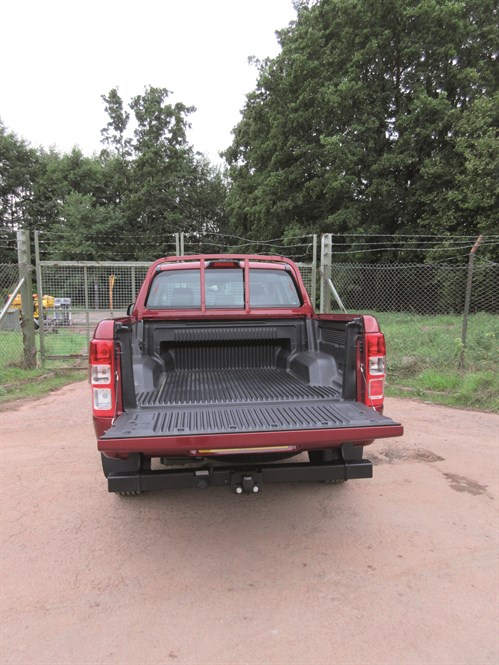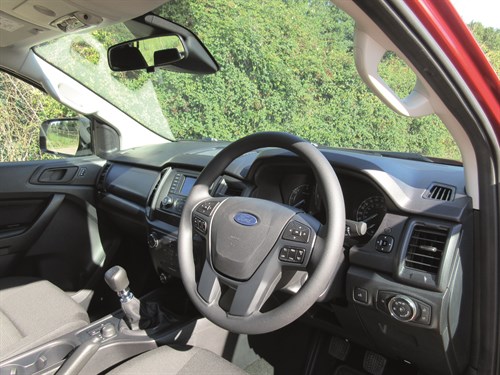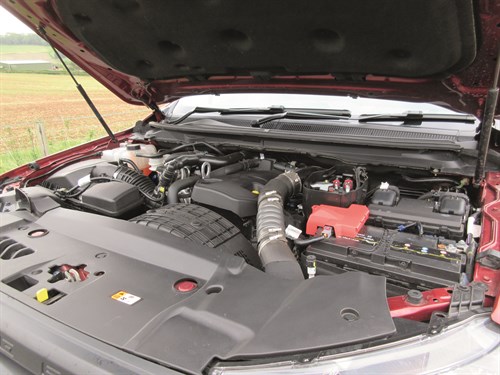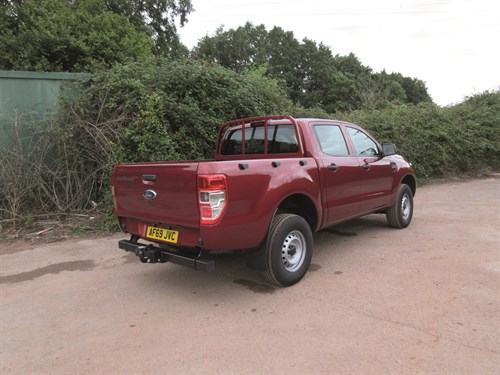Not all double-cab 4×4 pick-ups are marketed as high-specification alternatives to top-of-the-range company cars, whose sole acquaintance with hard work is towing a horsebox with a child’s pony in it at the weekend. Many of them are sold as workhorses that spend their days on dusty construction sites or struggling up muddy, deeply-rutted farm tracks.
When presented in entry-level XL trim Ford’s Ranger apparently falls into the workhorse category, but perhaps that is a bit of a misnomer. Despite its bottom-of-the-league status it is packed full of desirable kit, and would probably appeal to price-conscious retail buyers as well as to business users.
Facelifted not so long ago, and winner of the What Van? Pick-up of the Year for 2021, the Ranger can be ordered in single-cab, super-cab and four-door double-cab guise. The specification walk goes from XL through to XLT, Limited, Wildtrak and Thunder all the way up to the spectacular (and pricy) Raptor.
Power comes courtesy of a 2.0-litre EcoBlue diesel at 130hp, 170hp or 213hp. Buyers can choose either a six-speed manual gearbox or a 10-speed automatic box.
Worthy of mention is the single-cab chassis cab announced late last year, which looks like a useful platform for an off-roading tipper or a cherry picker.
On its way is a version of the Ranger developed in partnership with tuning company MS-RT which uses the 213hp Wildtrak auto double-cab as its platform. Complete with 29in alloy wheels and extended wheel arches, it will be in Ford dealerships this summer.
Prices have yet to be released.
In the meantime we opted for a, rather less glamorous, XL double cab with 170hp on tap and manual transmission. So how did we fare?

Load bay
Access to the cargo bay is by means of a tailgate, which can be dropped down until it is horizontal or lowered almost completely if you release the metal stays on each side. Our Ranger was equipped with a plastic bed-liner as part of an extra-cost optional package, which includes four tie-down points and a power socket.
The load area comes with exterior rope hooks – three down each side – plus a ladder rack with two hinged stops on top to prevent items resting against it sliding off to one side or the other. A work light is fitted should Ranger’s crew be busy early in the morning or late at night.

Interior and equipment
Manual air conditioning forms part of the four-door five-seater’s specifications, as do a pair of 12v power points on the fascia.
Big, electrically adjustable, heated exterior mirrors are included in the deal – but a shame there is no separate wide-angle section – as are electric windows in all four doors. Cruise control with a speed limiter is fitted too, as is an onboard computer. The windscreen and the cab’s rear window are heated.
A DAB radio with a 3.5in multifunctional display featuring Bluetooth connectivity is the centrepiece of the fascia. However, it is a basic package, with no satnav.
Storage facilities for all the bits and bobs drivers carry around with them include bins in each of the doors, a tray on top of the dashboard, another tray at the bottom with a USB socket, and a big, lidded, but not lockable glove box.
Between the front seats you will find a pair of cup holders, plus a lidded box with a tray beneath the lid.
Both the driver’s seat and the steering wheel are height-adjustable.
Each of the three rear seats has a lap-and-diagonal belt, plus an adjustable headrest. The occupants can access a 12v power point mounted in the back of the console separating the front seats.
Pull down a section of the back of the rear middle seat and it turns into a table with a couple of cup holders.
The legroom offered to rear passengers is fine for short local journeys, but could turn out to be insufficient for long motorway trips.
A stop/start system is fitted to help keep fuel consumption down, but this can be switched off as well.
Ventilated disc brakes at the front and drum brakes at the back provide the stopping power, and a comprehensive onboard safety system should help keep most drivers out of trouble. It includes ABS, emergency brake assist and electronic stability control (which can be turned off) with roll over mitigation and load adaptive control. Lane keeping aid, traffic sign recognition, hill start assist, hill descent control and trailer sway control are provided too.
Autonomous emergency braking with pedestrian protection is included as well as intelligent speed assistance. The latter identifies the speed limit on the road you are currently on and adjusts your maximum speed setting accordingly.
Driver and front passenger airbags, as well as side, curtain and driver’s knee airbags, are provided in case all the onboard safety systems fail to protect against catastrophe.
Other useful features include front fog lights and a Thatcham Category 1 security package with an alarm and an immobiliser.
A double-wishbone suspension setup with coil springs helps support the front, while leaf springs and an anti-roll bar do the honours at the rear. Our Ranger’s 16in steel wheels were shod with Continental Cross Contact LX 255/70 R16 tyres.
Boosted by electric power assistance, the rack-and-pinion steering delivers a 12.7m kerb-to-kerb turning circle.

Powertrain
Fitted with high-pressure common rail fuel injection, a variable-geometry turbocharger, a cast iron block and a cast aluminium head, our Ranger’s four-cylinder 16-valve diesel generates maximum power at 3,500rpm. Top torque of 420Nm bites across a 1,750rpm-to-2,250rpm plateau.
The 213hp version of the engine comes with twin low and high-pressure turbochargers.
Whichever variant you choose, the Ranger depends on AdBlue fed from a 20-litre reservoir to comply with the Euro 6c exhaust emission regulations.
Four-wheel drive is selectable and the electronically controlled transfer box offers three different modes or sets of gears: rear-wheel drive high range (2H), four-wheel drive high range (4H) and four-wheel drive low range (4L). A so-called shift-on-the-fly function allows drivers to switch to 4×4 at speeds of up to 70mph.
Driving
Gone are the days when 4×4 pick-ups lurched uncertainly around every bend, even when driven at moderate speeds. Although the steering could perhaps stand to be tightened up a little, the Ranger can be taken through corners with confidence.
It shares one characteristic with pick-ups of yore, however. The unladen ride is firm to the point of being downright unyielding, but this undoubtedly improves if you drop some weight in the back – 20 or so 37kg bags of grey 20mm Hereford gravel can work wonders, for example.
Though not quite as slick as we’ve come to expect from Ford, the quality of the gear change is acceptable.
For a big heavy pick-up, the Ranger seems pretty frugal, is certainly well put together and in-cab noise levels have been properly suppressed. However acceleration away from rest and up through the gears cannot be described as brisk, even with 177hp on tap.
Four-wheel drive is easy to engage. All you do is twist a knob between the seats which also allows you to engage the low-range set of gears if you are venturing off-road.
Contenting ourselves with squelching around a couple of muddy fields and a construction site, we found we didn’t need them.
The mud was deeper than we expected in one or two places, but the Ranger ploughed through it regardless, without breaking a sweat. Grab-handles are mounted above all the doors and on the A-pillars in case the off-road going gets rough, and the occupants of the cab need something to cling onto. Ground clearance is 232mm, with a wading depth of 800mm.

Operating
The Ranger is protected by a three-year/60,000 mile warranty with roadside assistance provided for the first year; a less-generous package than is provided by some of Ford’s
key competitors.
The paintwork warranty lasts for 12 months, which seems rather stingy, while the anti-perforation corrosion warranty runs for 12 years. Neither of these warranties has a mileage limit.
Service intervals are set at two years/18,000 miles.
A full-size spare wheel is provided – something we can only applaud – and the tools plus a medical kit are concealed under the rear seat cushion.
In terms of fuel economy, we averaged 37mpg – not far off the 40.3mpg NEDC (New European Drive Cycle) official combined figure quoted by Ford.
It should be noted, however, that NEDC figures are now being widely displaced in favour of more-realistic WLTP (World Harmonised Light Vehicle Test Procedure) figures.
Ford Ranger XL Double Cab 4×4 2.0L EcoBlue 170hp pick-up
Price (ex VAT) £23,795
Price range (ex VAT) £21,545-£41,145
Gross payload 1,140kg
Load length 1,613mm
Load width (min/max) 1,139mm/1,560mm
Load bay height 511mm
Loading height 835mm
Gross vehicle weight 3,270kg
Braked trailer towing weight 3,500kg
Residual value 30.5%
Cost per mile 49.9p
Engine size/power 1,996cc, 170hp @ 3,500rpm
Torque 420Nm @ 1,750-2,250rpm
Gearbox 6sp
Fuel economy (combined NEDC) 40.3mpg
Fuel tank 80 litres
CO2 183g/km
Warranty 3yrs/60,000mls
Service intervals 2yrs/18,000mls
Insurance group 42
Price as tested £25,025
* after 48 months @ 20,000mls/year – source – KWIKcarcost
Options
Metallic paint £500
Load box bed-liner inc power point and tie-down hooks £250
Trailer tow pack £400
Locking wheel nuts £80
Rivals
Isuzu D-Max
Price (ex VAT) £16,594-£40,680
Gross payload 1086-1282kg
Braked towing weight 2,500-3,500kg
Engines 164hp 1.9 diesel
Verdict: Isuzu has performed the neat trick of ensuring D-Max remains a credible workhorse while broadening its appeal to more leisure-oriented users with a variety of higher-specification models. A tough, no-nonsense package, it’s good to see that it is available in single and extended-cab configurations alongside the double-cab version. Unusually you can order it in 4×2 as well as 4×4 guise. More power is required however – a need Isuzu will have to address sooner rather than later.
Nissan Navara
Price (ex VAT)£22,650-£38,792
Gross payload 1,115-1,180kg
Braked towing weight 3,500kg
Engines 163hp, 190hp 2.3 diesel
Verdict: Revamped a while back, the Nissan Navara remains a sensible choice, with decent handling, plenty of towing capacity and sufficient off-road capability to keep most users out of trouble. As with so many other 4×4 pick-ups, the Navara’s on-highway ride is unfortunately not its strong suit – especially when unladen. Like Isuzu’s D-Max, it is available with a wide assortment of different trim levels. Our pick would be the more powerful of the two engine options if you regularly undertake longer journey times.
Toyota Hilux
Price (ex VAT) £21,540-£32,857
Gross payload 1,075-1,105kg
Braked towing weight 3,500kg
Engines 150hp 2.4 diesel, 204hp 2.8 diesel
Verdict: With a well-justified reputation for being able to stand up to the most monumental battering, the strongly built Hilux now packs more punch, thanks to the arrival of a 204hp 2.8-litre diesel. Its arrival is at the heart of a major upgrade, which includes everything from a retuned suspension to upgraded satellite navigation and some restyling. Its generous warranty package should be applauded – this is something that Ford might want to consider emulating.
The Final Verdict
Design 7/10 – A practical working tool with sufficient off-road capability for most users
Cabin 7/10 – Comfortable working environment with plenty of storage space
Ride 6/10 – Firm when unladen but improves when you drop some weight into the back
Refinement 8/10 – Well put together and in-cab noise levels are properly suppressed
Load area 7/10 – Good to see a ladder rack. Also good that it can tow such a heavy trailer
Handling/performance 7/10 – Former is exemplary for a large 4×4 pick-up but the latter can be sluggish
Engine/transmission 7/10 – Decent fuel economy and four-wheel drive is easy to engage
Standard equipment 8/10 – Not short of kit for an entry-level model and the stress on safety is praiseworthy
Operating costs 7/10 – Warranty could be more generous but a Ford badge should ensure strong second-hand value
What Van? subjective rating 7/10 – Sensible well-equipped workhorse that covers most of the bases
Overall rating: 71/100





